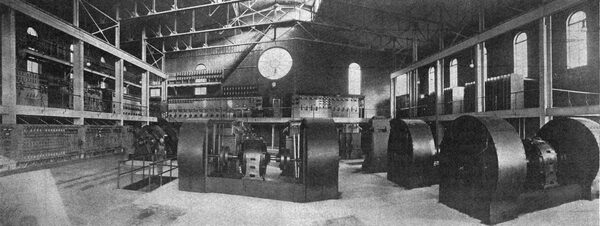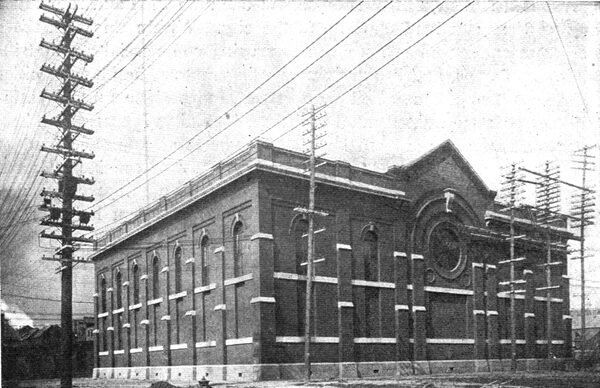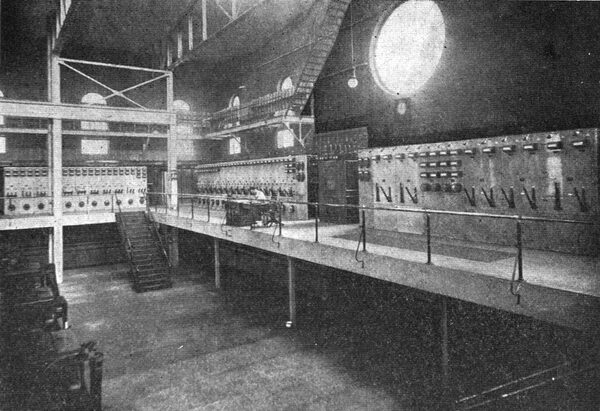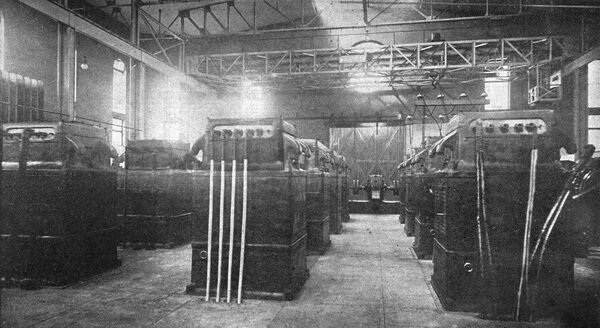[Trade Journal]
Publication: Electrical World and Engineer
New York, NY, United States
vol. 42, no. 23, p. 905-909, col. 1-2
Montreal, the Greatest Centre of Transmitted Power--I.
BY ALTON D. ADAMS.
INTRODUCTION.
MONTREAL, Canada, consumes more electrically transmitted water power than any other city in the world. This power is drawn from three generating stations located on as many different rivers at distances that range up to about 85 miles from the central substation in the city. These rivers, the St. Lawrence, the Richelieu and the St. Maurice, draw their water supplies from half a continent. With the vast drainage area of the Great Lakes behind the St. Lawrence, the entire Champlain Basin between the Green and Adirondack Mountains to gather water for the Richelieu, and a great stretch of northern Canada to supply the St. Maurice River, the reliability of electrical supply from water power is assured in Montreal. The superlative capacity of the water-driven apparatus in this electrical supply system seems evident from a statement of the figures for the generating and sub-stations. At Chambly power house, on the Richelieu River, 17 miles by the transmission line from the central sub-station in Montreal, the combined capacity of the main electric generators is 16,800 kw. The Lachine power house, on the St. Lawrence, five miles from the sub-station just named, contains main generators of 6,000 kw total capacity. Both of these power plants are devoted exclusively to the operation of the Montreal system. Neglecting the total equipment of the great power house at Shawinigan Falls, on the St. Maurice River, which is operating under a head of 145 ft., and in which three turbines are installed at present, having a capacity of 6,000 hp each, and generators of 3,750 kw, and whence energy is transmitted 85 miles to a sub-station in the suburbs of Montreal, the capacity of transformers at this sub-station is 5,000 kw, and they require about 6,000 kw in generator capacity at the Shawinigan plant. The total rating of the present generators in water-power stations, devoted to electrical supply in Montreal, is thus 28,800 kw. This capacity will shortly be increased in two directions. A fifty-year contract requires the company operating the Shawinigan plant to deliver up to 20,000 hp for electrical supply in Montreal. Still another water power located at Soulanges, on the St. Lawrence, is about to be developed and transmitted for the city system.
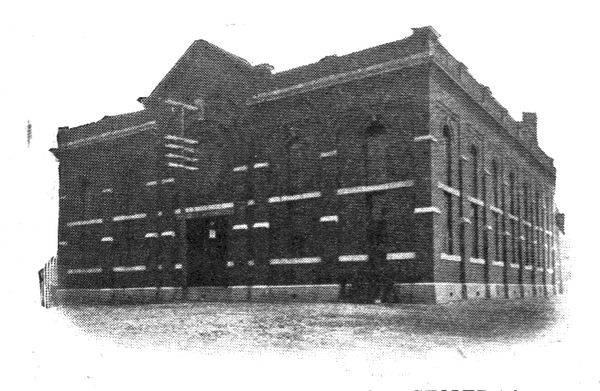 |
| Fig. 1. -- Rear View of Central Station, Montreal. |
In anticipation of the increase of capacity at the water power -plants the sub-stations in Montreal have been equipped beyond immediate requirements. Besides that of the Shawinigan system already mentioned, there are two sub-stations in Montreal devoted to general electrical supply. At one of these, known as the McCord Street sub-station, the total capacity of transformers that receive the high-tension transmitted energy is 7,000 kw. In the main or central sub-station, the total capacity of transformers connected to the transmission lines is now 27,500 kw with room for an increase. Including the 5,000 kw at the Shawinigan sub-station, which is entirely devoted to the Montreal electrical supply system, save for one item of 250 hp, the combined capacity of stepdown transformers is thus 39,500 kw or 52,000 hp. It is safe to say that no other city on the American continent, or even in the world, has an equal capacity of stepdown transformers delivering energy from water powers to an electrical supply system for all purposes.
Besides the water-power plants and sub-stations already named, the system includes five steam power stations at as many points about the city and suburbs, with a combined capacity of 5,700 kw. These steam plants are in large part a legacy of former conditions, and are now held as a reserve for the water power system. The largest of these steam-driven stations, that on Queen Street, has a capacity of 2,400 kw, and has been remodelled and made fire-proof during the past year.
THE AREA OF SUPPLY.
Electric light and power supply is distributed by the Montreal system in the city and island of that name for a distance of about fourteen miles along the river front, and to an average width of between three and four miles back from its bank. Included in the service area is a strip of territory about one mile wide and four miles long on the main land opposite to the city. Within this area there are at present served 11,152 customers using commercial arc and incandescent lamps, and 870 customers using motors, besides the cities and towns that are supplied with street lamps. The municipalities whose streets are lighted number fifteen, including Montreal, and all except two of these are on the island. The total connected load of street lamps numbers 1,717 of the arc and 577 of the incandescent type. Commercial lighting service is rendered to 11,152 customers, who have connected to the system 299,903 incandescent lamps, 1,514 arc lamps and 405 pieces of various apparatus, such as fans and heaters. Power service is rendered to no fewer than 87o consumers, who employ 'Jog electric motors with an aggregate capacity of 19,172 hp. From these figures it may be noted that the utilization of water powers has made the operation of motors an exceptionally important part of the business of the Montreal system. The commercial lamps above named, together with a part of the incandescent street lamps, are operated through 2,161 service transformers with an aggregate capacity of 13,249 kw. For the motor load 695 transformers with a total capacity of 6,980 kw are employed, but these transformers do not operate all of the connected motors, because many of these motors are of the direct-current type, and many of the alternating motors operate at the full voltage of distribution so that no transformers for them were required.
| |||
| Fig. 2. -- General View of Central Station, Montreal. |
WHAT CONSTITUTES THE SYSTEM.
This great system, which constitutes the only public supply of light and power in Montreal, has been welded together out of diverse elements. The Montreal Light, Heat and Power Company, the owner of the system, was incorporated by the Quebec Legislature in March, 1901, for the purpose of consolidating all the gas and electric companies doing business in the city. In conformity with this purpose the charter of the company authorizes it to acquire plants for the supply of gas, electricity or other source of light, heat or power, by purchase, lease or otherwise. Furthermore, the company may lease and operate all or any part of the plants of any other company engaged in the supply of light, heat and power, and may acquire and hold the stocks and bonds of any such corporation. When the Montreal Light, Heat and Power Company has acquired the plant of any other company engaged in similar lines of business, then the Montreal Company may exercise the charter rights and franchises of such other company. Besides the foregoing powers, the Montreal Company has the right to construct its pipes, lines and conduits under or over the public streets and highway of that city or of any place or territory within one hundred miles therefrom in any direction.
| |||
| Fig. 3. -- Front View of Central Station, Montreal. |
Pursuant to these liberal and important powers the Montreal Light, Heat and Power Company acquired a majority of all the capital stock of each of the following named companies : The Montreal Gas Company, the Royal Electric Company, the Montreal & St. Lawrence Light & Power Company, the Imperial Electric Light Company, Ltd., the Lachine Rapids Hydraulic & Land Co., Ltd., the Standard Light and Power Company, the Citizens' Light & Power Company, Ltd., the Temple Electric Company. The Montreal Light, Heat and Power Company, together with the eight subsidiary companies just named, controls the entire supply of gas and electrical energy in that city and its suburbs. The dates of incorporation of these subsidiary companies are of interest as showing the great increase in public service that has resulted from the introduction of electrical supply and the application of water power therein. The Montreal Gas Company was incorporated in 1847, and engaged in the supply of gas in Montreal and its suburbs. In 1884 the Royal Electric Company was chartered to supply electrical energy in Mon-treal, and at the time of the consolidation was the largest distributor of that product in the city. The Montreal & St. Lawrence Light and Power Company was incorporated in 1888, and has built the large hydro-electric plant at Chambly, that now forms a part of the Montreal electric system, and transmitted the energy there developed to the city. Energy from this plant was first used at Montreal in August, 1899. The Imperial Electric Light Company was chartered in 1896 to supply electrical energy in Montreal from a steam power plant. The Lachine Rapids Hydraulic Land Company, Limited, was incorporated, in 1896, to develop the Lachine Rapids and transmit electrical energy therefrom for use in Montreal, which has since been done. Both the Citizens' Light and Power Company and the Standard Light and Power Company were incorporated in 1892 for the purpose of either gas or electrical supply.
From the above it appears that the Royal Electric Company, one of the subsidary corporations just mentioned, is the oldest of those now engaged in electrical supply in Montreal, as its formation dates from 1884. It would be interesting, if possible, to trace the increase of electric loads among all the companies at Montreal during past years, but the facts are not at hand for any of these companies save the Royal Electric. Figures for the loads of this company are, however, no doubt more representative and larger than figures for any one of the other companies concerned. Direct-current arc lamps connected to the circuits of the Royal Electric Company numbered 1,287 in the year 1890; 1,666 in 1895, and 1,859 in 1900, showing an increase of 44 per cent. during the ten years. During the same period the load of arc and incandescent lamps on the alternating-current circuits rose from an equivalent of 1,835 incandescent lamps of 16 cp each to an equivalent of 93,498. In other words, the load of arc and incandescent lamps on alternating circuits was 59 times as great in 1900 as it was in 1890. Direct-current motors first appeared on the circuits of the Royal Electric Company in 1892, when their total rating was only 50 hp, but by 1900 this capacity had risen to 1,253 hp, or 25 times the rating in the earlier year. The latest factor 'in the electric load was the alternating-current motor, which did not appear in the returns until 1897, and was then credited with a combined rating of 18 hp. Three years later, in 1900, the capacity in connected motors of this type reached 3,417 hp, representing an average addition of more than 1,100 hp in capacity yearly. It is hard to believe that this rapid increase of electrical loads was not due in some measure to the utilization of water power, for between May 31, 1899, and May 31, 1900, the Royal Electric Company secured control of the hydroelectric plant at Chambly, energy from that plant was delivered at Montreal in August, 1899, and the rise of electric loads was more rapid during the year between the two dates just named than in any other of the decade. Thus, during the twelve months that ended May 31, 1900, the increase on the Royal system of the equivalent load of 16 cp incandescent lamps was 14,460, and the rise of capacity in connected motors was 116 hp for those of the direct-current, and 2,176 hp for those of the alternating type. To water power must also be traced the strong tendency to consolidation that culminated in 1901.
The charters of the Montreal Light, Heat and Power Company and of its subsidiary companies are perpetual, and the stockholders of the former company, by a vote of two-thirds of the stock represented at any special general meeting called for the purpose, may increase its capital stock to any amount deemed necessary for its purposes. Debenture bonds may be issued by the company to an amount equal to 75 per cent. of its capital stock, and these bonds may be secured by a transfer to trustees of all or any part of its assets. Up to April 30, 1903, the Montreal Light, Heat & Power Company had issued $17,000,000 in capital stock, and $3,500,000 in 4% per cent. bonds. During the year ending at the date just named, the excess of earnings by the company over its operating expenses was $900,872.95. This excess of earnings over operating expenses amounted to 46 per cent. of the gross earnings of the company in that year. For the year ending April 3o, 1902, the first after the formation of the Montreal Light, Heat & Power Company, the company earned $821,217.45 above the expenses of operation, and this sum was 46 per cent. of its gross earnings in that year. Besides paying all operating expenses and interest charges on its bonds and loans the Montreal com-pany declared four quarterly dividends of 1 per cent. each, during each of the two fiscal years just named, the only ones of its existence. After all these payments there remained a surplus of over $140,000.
| |||
| Fig. 4. -- Distributing Switchboard and Transformer Panels. |
FEATURES OF DISTRIBUTION.
Electrical supply in Montreal and its suburbs is distributed from three sub-stations, which are designated as the central, the McCord Street, and the Shawinigan sub-station respectively. The central substation is nearest of the three to the business center of the city, the McCord Street sub-station is about one-half mile distant to the west, and the Shawinigan sub-station is approximately 3-5/8 miles to the east. At each of these sub-stations the energy transmitted from one or more of the water power plants is transformed or transformed and converted to alternating current at 2,400 volts, 63 cycles per second, and either two or three-phase. At the central sub-station a portion of this 2,400-volt alternating current is transformed to 4,000-volt constant current for the series arc lamps, and another portion of the 2,400-volt current is transformed and converted to direct current at 250 volts for a three-wire system of 500 volts between outside wires, that carries a part of the motor load. All three of the sub-stations are tied together by the 2,400-volt feeders, so that the energy received from either water power plant may be delivered to consumers on any part of the distribution system. Constant, direct current is supplied for a part of the series street lamps by means of motor-driven arc dynamos.
| |||
| Fig. 5. -- Transformers, Central Station. |
| |||
| Fig. 6. -- Switchboard for City Lighting. |
Of the total number of arc street lamps, 1,717, the enclosed series alternating arcs comprise 1,333, and the remaining 384 lamps are of the series open direct-current type. All of these street arc lamps are of nominal 2,000 cp each. The enclosed alternating arcs operate nominally on 8o volts and 7.5 amp. each, or 480 actual watts. On the direct-current arc lines the rating is 9.6 amp.
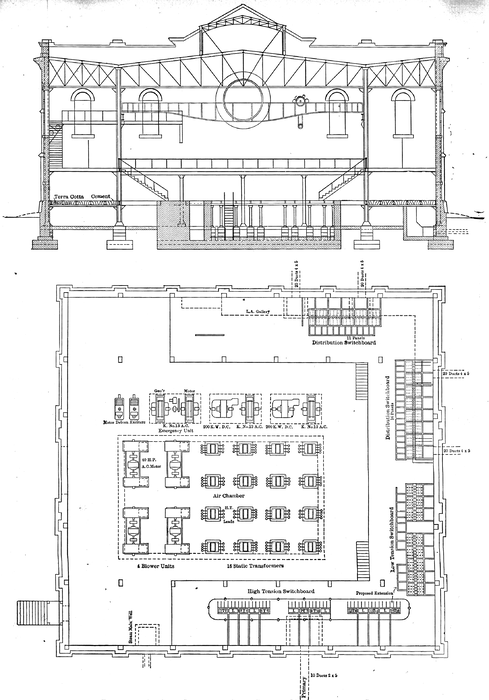 |
| Figs. 7-8. -- Cross-Section and Floor Plan of Montreal Central Station. |
Of the 577 incandescent street lamps, 106 of 65 cp and 273 of 32 cp are on the constant alternating-current lines, 37 of 32 cp are operated by constant direct-current circuits, 50 of 32 cp are in multiple on the 220-volt system, and 91 of 32 cp and 18 of 16 cp each are in multiple at no volts. The 299,903 incandescent lamps in commercial service include a variety of candle-powers below 16, so that the equivalent number of 16-cp lamps would be somewhat less than this total figure. The constant-potential commercial arc lamps of both the enclosed and open types number 1,277 on alternating circuits. Commercial service also includes 23 constant-current, enclosed alternating arcs and 214 direct-current series open arc lamps.
Most notable in this supply system is the load of stationary motors, because of their large number, great aggregate capacity and the unusual average capacity of each. Of the 1,109 motors connected to the distribution lines, 580 motors in use by 426 customers are of the alternating type and have an aggregate capacity of 16,556 hp, giving an average capacity of 28.4 hp each. Comparing these motors with the number of customers using them, it appears that the average was 1.36 motors and 38.8 hp per customer. The exceptionally large average horse-power per motor and per customer points clearly to the extensive use of these alternating motors in manufacturing operations. Some of these alternating motors are of the synchronous, but the greater number is of the induction type, and all are supplied with current of 63 cycles and either two or three-phase. Most of these motors are operated from the 2,400-volt circuits through transformers that lower the voltage to about 550; but some of the large sizes receive the full line voltage in their windings. Direct-current motors number 529, are in use by 444 customers and have an aggregate capacity of 2,616 hp. The average capacity of these motors is thus almost 5 hp each, and the average per customer is 1.2 motors and 6 hp. Comparing these figures with those for alternating motors it appears that the average power per customer and per motor is nearly six times as great for the alternating as for the direct-current type. From this fact the obvious conclusion is that the alternating type of motor is more generally applied where comparatively large powers are required. The two largest consumers of electric power connected to the Montreal system—that is, the Montreal Street Railway Company and the Dominion Cotton Mills Company—use 21 motors of the alternating type that have an aggregate capacity of 8,005 hp, besides some smaller sizes. If the number of these exceptionally large motors and their total capacity are deducted from the corresponding figures for all motors of the alternating type, the result shows 559 of these motors with a combined rating of 8,551 hp. These last-named figures correspond to a capacity of 15.3 hp per motor on an average, or 2.5 that of the like average for all of the direct-current motors. This again brings out the fact that the alternating motors have been more generally selected than the direct-current type by the users of large amounts of power.
The Montreal Street Railway Company has a larger capacity in motors connected to the system of the Montreal Light, Heat & Power Company than any of its other customers. This capacity amounts to a total of 4,955 hp and is made up by seven 2,200-volt, two-phase motors that operate with alternating current of 63 cycles per second. Six of these motors are of the induction type and rated at 700 hp each, while the seventh is a synchronous motor of 715 hp. For the supply of energy to these motors seven two-phase circuits are run from the central sub-station of the electrical supply system to the generating station of the street railway company, a few blocks distant. These induction motors are believed to be among the largest of this type in use anywhere. It is believed that these induction motors require less skill in their operation, and cause less fluctuation of voltage in the electric supply system than synchronous motors of equal capacity. On the other hand, one disadvantage of induction motors, that of a very short air-gap between the rotating and stationary parts, is here illustrated. Thus, in these great induction motors of 700 hp each the air-gap for each of two is said to be only 3/32 in., and the air-gap for each of four only 0.0825 in. from iron to iron. Each of these seven motors is direct-connected to a continuous-current generator that supplies the street railway system at about 550 volts.
The plant of the Dominion Cotton Mills Company is probably one of the largest of its kind that draws its power from a public system of electrical supply. In these cotton mills the total number of electric motors is 27, and their combined rating amounts to 3,412 hp, divided as follows: Number of motors, 5 of 300 hp each, 1 of 240 hp, 5 of 200 hp, 1 of 150 hp, 2 of l00 hp, 2 of 75 hp, 1 of 50 hp, 1 of 30 hp, 1 of 20 hp, 2 of 15 hp, 2 of 10 hp, 1 of 7 hp, 3 of 5 hp. All of these motors in the cotton mills are of the induction type, save one of zoo-hp capacity, which is synchronous. The fact that the Montreal electrical supply system is able to furnish power for this great manufacturing plant on terms that make it unprofitable for the latter to operate with steam is a striking illustration of the advantages of transmitted water power.
Of the 2,161 service transformers used for lighting service on the Montreal system, 1,068 are of less than 5-kw capacity each, 314 have an individual rating of just 5 kw, and 779 transformers are rated at 7-1/2 to 60 kw each. All of these lighting transformers have a combined rating of 13,249 kw, and of this total the transformers of less than 5 kw each represent 2,222 1/2 kw, the transformers of just 5 kw each 1,570 kw, and those of more than 5 kw each an aggregate of 8,930-kw capacity. Of the 695 transformers used for power service, 273 are rated at less than 5 kw each, 98 transformers have just this individual capacity, and 324 transformers are of larger sizes up to 170 kw. The combined rating of 6,980 kw in these transformers used for power purposes is divided into 620 kw for those of less than 5 kw each, 490 kw for those of just 5 kw rating, and 5,867 1/2-kw capacity in transformers that range from 7-1/2 to 170 kw each.
Comparing the lighting and the power transformers it appears that the average rating of all the former is 6.1 kw, and of all the latter 10.0. Of the aggregate rating of 13,249 kw for all lighting transformers, 67 per cent. is in units of more than 5-kw capacity each, while of the 6,980 kw of total capacity in power transformers 85 per cent. is represented by those of more than 5 kw each. These figures bring out one desirable feature of a motor load, namely, that the transformers required for its operation are usually of larger average capacity and consequently of higher efficiency than those used for lighting. Of course, large motors of 100 or more horsepower each have the further advantage that they may take current directly from the distribution lines, and thus require no service transformers whatever.

